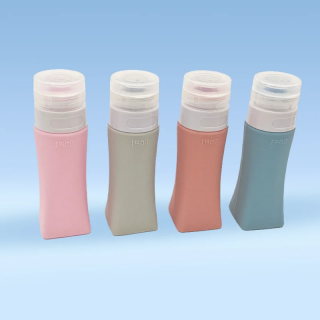Can silicone cosmetic bottles be sterilized at high temperatures? Are they hygienic and safe for reuse?
2025-09-29
Silicone cosmetic bottles can indeed be safely sterilized at high temperatures, which is one of their core advantages over ordinary plastic containers. High-quality food-grade or medical-grade silicone offers excellent temperature resistance, typically withstanding temperatures ranging from -40°C to 230°C. This means you can safely sterilize them at high temperatures.

Common Sterilization Methods
Immersing silicone cosmetic bottles completely in boiling water for 3-5 minutes effectively kills common bacteria and microorganisms. Steam sterilization is also an ideal option. Place the cleaned bottles in a steam sterilizer or steamer and heat them at temperatures above 100°C for 10-15 minutes for a more thorough sterilization. It's important to thoroughly remove any remaining cosmetics from the bottle before sterilization to prevent the high temperature from degrading the ingredients, creating odors, or causing contamination.
Precautions for Reuse
Before refilling a silicone cosmetic bottle, perform standard cleaning. First, rinse the inside of the bottle with running hot water. Then, use a neutral detergent and a bottle brush to carefully scrub the inside of the bottle and the threads, as these areas are prone to residue accumulation. After cleaning, the most important thing is to dry the bottle thoroughly. Place the bottle upside down in a clean, ventilated area to air dry. If necessary, use a sterilized cotton swab to dry any moisture from the joints. A humid environment is a breeding ground for mold, and filling the bottle before it is completely dry can increase the risk of secondary contamination. During daily use, avoid mixing different types of cosmetics to prevent cross-contamination. In particular, mixing oil-based and water-based skincare products can make cleaning more difficult.
![]()
Precautions for long-term use
Material aging can lead to health risks and pigmentation. Although silicone is inherently stable, frequent high-temperature sterilization and physical compression can accelerate aging. If the bottle shows permanent deformation, hardening, cracking, or a sticky surface, its sealing and antimicrobial properties have been significantly reduced and should be replaced immediately. Another common problem is that silicone slowly absorbs pigments from cosmetics, especially when used with dark serums or hair dyes, which can gradually stain the bottle. While this does not affect basic safety, it can mask stains within the bottle and hinder cleaning decisions. It is recommended to use specific bottles for specific purposes or to inspect and replace the bottle regularly.
| Aspect | Details |
|---|---|
| Material Properties | Food or medical grade silicone withstands -40°C to 230°C temperatures |
| Boiling Sterilization | Immerse empty bottles in boiling water for 3-5 minutes |
| Steam Sterilization | Process bottles above 100°C for 10-15 minutes in sterilizer or steamer |
| Pre-Sterilization Prep | Remove all cosmetic residue before heating to prevent contamination |
| Cleaning Protocol | Rinse interior with hot water scrub with neutral detergent and bottle brush |
| Critical Drying Step | Air-dry bottles upside down use sterilized swabs on threads to remove moisture |
| Usage Warning | Never mix oil-based and water-based products in same bottle |
| Aging Indicators | Replace if bottles show cracking hardening stickiness or permanent deformation |
| Pigmentation Issue | Silicone absorbs cosmetic pigments over time may mask internal residue |
| Replacement Strategy | Use dedicated bottles per product inspect regularly replace every 1-2 years |




